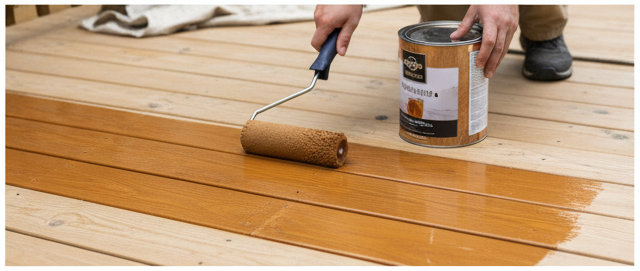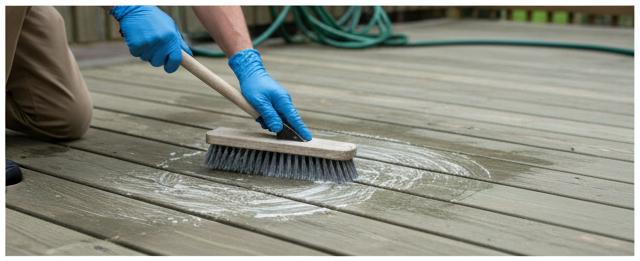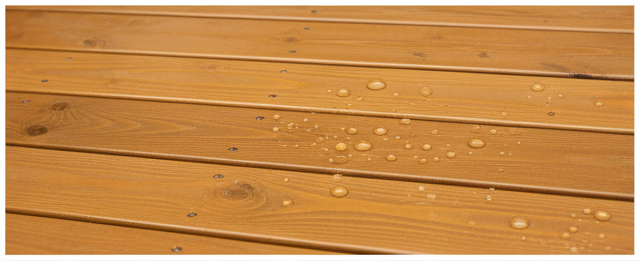Deck Care Encyclopedia
The permanent, no-nonsense reference for making decks last longer. This encyclopedic guide covers maintenance by wood type, climate, and finish, plus chemistry that actually works, safety around pools, and 10-year cost math—so you can act, not guess.
How to Use This Page
- Pick your deck type + climate below and follow the matching schedule.
- Open the linked deep dives (on our site) for step-by-step methods and product-type choices.
- Bookmark it—this page is designed as a living, always-useful reference.
Field note (15+ years, all climates): 80% of deck failures come from three mistakes: (1) same maintenance everywhere (no climate adaptation), (2) wrong finish for the species, (3) first treatment applied too soon/too late. Penetrating systems matched to species + climate win the 10-year total cost every time.
Deck Types & Their Core Needs
Pressure-Treated Pine (PT)
- Best for: Value, framing, wide availability.
- Risks: Wet chemicals at install, green/brown tint, early checking.
- Finish: Penetrating oil semi-transparent after the water-bead test passes (water soaks in within ~5 min).
- Deep dive: Pressure-Treated Lumber Care
Cedar & Redwood
- Best for: Lower weight, natural rot resistance, warm color.
- Risks: Tannin bleed, mildew in humidity.
- Finish: Penetrating semi-transparent with strong mildewcides; brighten (oxalic) after cleaning.
Tropical Hardwoods (Ipe, Cumaru, Mahogany)
- Best for: Density, dimensional stability, premium look.
- Risks: Mill glaze and natural oils block penetration; film finishes peel.
- Finish: True penetrating hardwood oils only; expect more frequent light coats to preserve color.
Composite & Synthetic Decking
- Best for: Low surface maintenance (but structure beneath is often PT).
- Risks: Algae film in shade, slipperiness when wet.
- Care: Composite-safe cleaners; consider non-slip additives near water.
Climate-Specific Deck Maintenance Schedules
| Wood Type | Coastal (Salt & UV) | Humid/Wet | Hot/Dry Desert | Cold/Snow | Best Finish Type | Typical Recoat | Notes |
|---|---|---|---|---|---|---|---|
| PT Pine | Monthly salt rinse; first stain 3–6 mo after build | Cleaner w/ biocides 2×/yr | High-pigment semi-solid | Seal before freeze (fall) | Penetrating oil, semi-transparent | 24–30 mo | Do the water-bead test before first coat |
| Cedar/Redwood | Marine-aware mildewcides | Mildew watch; brighten (oxalic) | Semi-solid for UV | Avoid rock salt de-icers | Penetrating semi-transparent | 18–24 mo | Tannin stains need brightening after cleaning |
| Ipe/Hardwoods | Salt wash + true penetrating oils | Ensure airflow under/around boards | More frequent light coats for color | Monitor shrink/swell cycles | Hardwood penetrating oil | 12–18 mo | Never film-forming on beachfront hardwoods |
| Composite | Add non-slip near pools | Oxygen bleach for biofilm | Minimal UV chalking | Plastic shovels only | — | — | Structure below may be PT → follow PT schedule for framing components |
Coastal note: Plan exterior assemblies together: vertical cladding near decks affects salt-wash cadence and brightening cycles.
If you want to coordinate your deck schedule with fences, siding, and outdoor furniture so everything ages on the same cadence, use the master hub: the Exterior Wood Care Guide. For the product decision that impacts longevity and labor the most, compare options here: Deck Sealer vs Stain.
Climate product picks for decks:
→ Best Deck Stain for Coastal Climates (2025)
Finish Types: What Actually Lasts

| Finish Type | How It Protects | Pros | Cons / Failure Mode | Typical Longevity* |
|---|---|---|---|---|
| Penetrating oil, semi-transparent | Soaks in; pigment blocks UV | Moves with wood; easy recoats; natural look | Needs periodic refresh | 24–36 mo |
| Penetrating oil, semi-solid | More pigment = more UV block | Best for desert/high UV | Hides grain more | 36–60 mo |
| Water-based stain | Binds near surface (low film) | Fast dry, low odor | Can struggle on fresh PT/hardwoods | 18–30 mo |
| Film-forming (solid/paint) | Sits on surface | Color uniformity | Peels when moisture cycles under the film | 36–84 mo (decks risky) |
| Clear sealer | Water repellency | Keeps wood tone short-term | Weak UV defense → quick graying; yearly treadmill | 12–18 mo |
*Real-world ranges; climate and exposure dominate outcomes.
Decision help: Deck Sealer vs Stain: Which Lasts Longer?
Year-Round Deck Care Calendar
Spring (Deep Clean & Inspect)
- Inspect structure & railings; tighten/replace fasteners.
- Clean: Sodium percarbonate (oxygen bleach) solution (see ratios below).
- Brighten: Oxalic acid on cedar/redwood; optional on PT if needed for even tone.
- How to Clean a Wood Deck Without Pressure Washing
Summer (UV Defense & Touch-Ups)
- Spot-coat high-sun areas; audit non-slip around water features.
- Non-Slip Deck Coatings
Fall (Prime Staining Window)
- Full stain cycles before freeze–thaw; check dry weather window.
- Deck Cleaning Solutions: Oxalic vs Percarbonate
Winter (Monitor & Protect)
- Avoid metal shovels; check after thaws; keep drainage paths clear.
Cleaning Without Damage (Chemistry That Works)
Why not pressure wash? It raises grain, forces water deep, and accelerates rot. Let chemistry do the work.

Two-Step Method (Pro Standard)
- Clean – Sodium Percarbonate (Oxygen Bleach)
- Mix (general soil): ~1 cup powder per 1 gal warm water (≈ 8 oz/gal).
- Heavy soil/mold: up to 2 cups/gal.
- Dwell: 10–20 min (keep wet), then scrub with the grain; garden-hose rinse.
- Brighten/Neutralize – Oxalic Acid
- Mix: ~6–8 oz crystals per 1 gal water (manufacturer ranges vary).
- Dwell: 5–10 min; light scrub; thorough rinse.
- Restores color, removes rust/tannin, neutralizes alkaline pH before staining.
Avoid: Household chlorine bleach (lignin damage, corrosion) except for targeted sanitation.
Deep chemistry explainer: Oxalic Acid vs Sodium Percarbonate · Hands-on method: Clean a Wood Deck
Staining & Sealing: Failsafe Protocol

- Moisture readiness
- New PT: wait 3–6 months then do the water-bead test (water must absorb within ~5 min).
- Hardwoods: remove mill glaze (full clean + brightener), then allow 24–48h dry.
- Prep sequence
- Clean (percarbonate) → Brighten (oxalic) → Rinse thoroughly → Dry 24–48h (longer in humidity).
- Application
- Stir, don’t shake. Two thin coats, back-brushed; maintain wet edge.
- Pool zones: mix aluminum oxide grip additive into every coat to hit wet COF ≥ 0.60.
- Cure & upkeep
- Gentle wash quarterly in humid/coastal climates; plan visual checks each spring.
- Recoat by appearance (fading, water no longer beads) not by calendar alone.
PT first-year details: Pressure-Treated Lumber Care
Safety & Pool-Area Traction (High-ROI)
Pool-adjacent decks should target wet COF ≥ 0.60. The most durable, low-visibility solution is a penetrating stain with aluminum oxide additive in every coat. For integrated pool hydraulics, splash-zone detailing, and finish longevity planning.
Full methods and product-type rankings:
→ Non-Slip Deck Coatings: Additives vs Textured Stains vs Strips
Common Problems & Proven Fixes
| Problem | Likely Cause | Fix / Prevention |
|---|---|---|
| Premature graying | Weak UV defense (clear sealer) | Switch to pigmented penetrating stain (semi-transparent/solid as needed) |
| Peeling finish | Film-forming on horizontal; trapped moisture | Strip/restore → penetrating system; improve drainage & ventilation |
| Mildew/algae return | Residual spores; shaded/time-wet areas | Two-step clean; choose stain with mildewcides; increase sun/air where possible |
| Fuzzy/rised grain | Aggressive pressure washing | Hand scrub chemistry; light sand to smooth; re-oil |
| Black stains around fasteners | Iron/copper reactions; moisture | Oxalic brightener; upgrade to stainless/compatible coated hardware |
| End-grain rot at cuts | Unsealed cuts; ponding | Seal end-grain; add drip edges; re-grade for drainage |
Deck Cleaning Methods: What Works Best (Summary)
| Method | Effective For | Risk to Wood | Gear Needed | Notes |
|---|---|---|---|---|
| Oxygen bleach + brush | General dirt, mold/mildew, algae | Low | Bucket, brush, hose | Control dwell; let chemistry work |
| Oxalic brightening | Tannin, rust, cedar/redwood refresh | Low (PPE needed) | Pump sprayer, PPE | Always after a clean (neutralizes pH) |
| Pressure washing | Visual dirt removal | High | Washer (avoid on wood) | Use only as soft-wash (<500 PSI) if you must |
| Household chlorine bleach | Sanitizing, spot bio kill | Medium-High | Spray bottle, PPE | Can damage lignin/metal; rinse thoroughly |
Refinish vs Replace: 10-Year Cost Reality (Typical Mid-Size Deck)
| Option | Upfront (Materials+Labor) | 10-Yr Maintenance (Est.) | 10-Yr Total | Notes |
|---|---|---|---|---|
| Penetrating semi-transparent (wood) | $ | $$ (clean + light recoats) | $$–$$$ | No stripping cycles; predictable upkeep |
| Film-forming stain/paint (wood) | $$ | $$$$ (peel repair/strip) | $$$$+ | Horizontal peel risk → highest life-cycle cost |
| Hardwood + penetrating oil | $$$ | $$ (annual light coat) | $$$–$$$$ | Best aesthetics; discipline required |
| Composite surface on existing PT frame | $$$ | $ (wash) | $$$ | Verify frame (PT) lifespan; may still need non-slip |
Use your local rates; the pattern (not the dollar signs) is what matters.
Hardware & Fasteners (Silent Failure Points)
- Use stainless or high-grade coated fasteners—mandatory near salt air.
- Break galvanic pairs (e.g., stainless screws with compatible hangers).
- Annual check: joist hangers, ledger flashing, rail posts, stair stringers.
Professional vs DIY (What to Outsource)
- DIY friendly: Two-step cleaning, penetrating stain recoats, non-slip additive mixes.
- Hire out: Full strip of failed film finishes, structural repairs (ledger/footings), and complex stair re-builds.
Case Snapshots
- Beachfront Ipe (Atlantic): Film-forming “marine” finish peeled in 18 months. Restored with penetrating hardwood oil; light coat every 12–16 months → stable, no peel cycles.
- PT Suburban Deck (Midwest): Stained 4 weeks after build → flaked inside 6 months. Redone after proper dry-out + two-step prep → now on a 24–30-month cadence.
- Shaded Cedar (PNW): Mildew recurring every spring. Switched to percarbonate + oxalic routine and stain with stronger mildewcide; added airflow under boards → algae growth cut dramatically.
Internal Deep Dives
- Strategy hub: Deck Care Encyclopedia (you’re here)
- Finish choice: Deck Sealer vs Stain
- Coastal picks: Best Deck Stain for Coastal Climates
- Cleaning chemistry: Oxalic vs Percarbonate
- Gentle method: Clean a Wood Deck (No Pressure Washer)
- Traction & safety: Non-Slip Deck Coatings
- PT timelines: Pressure-Treated Lumber Care
Your deck maintenance strategy aligns best with the seasonal routines inside the Exterior Wood Care Guide, while surface preparation and cleaner choice are detailed in Deck Cleaning Solutions.
References
Useful background and homeowner references:
This Old House deck checklist • DeckStainHelp stain vs sealer • Trex RainEscape cleaning tips